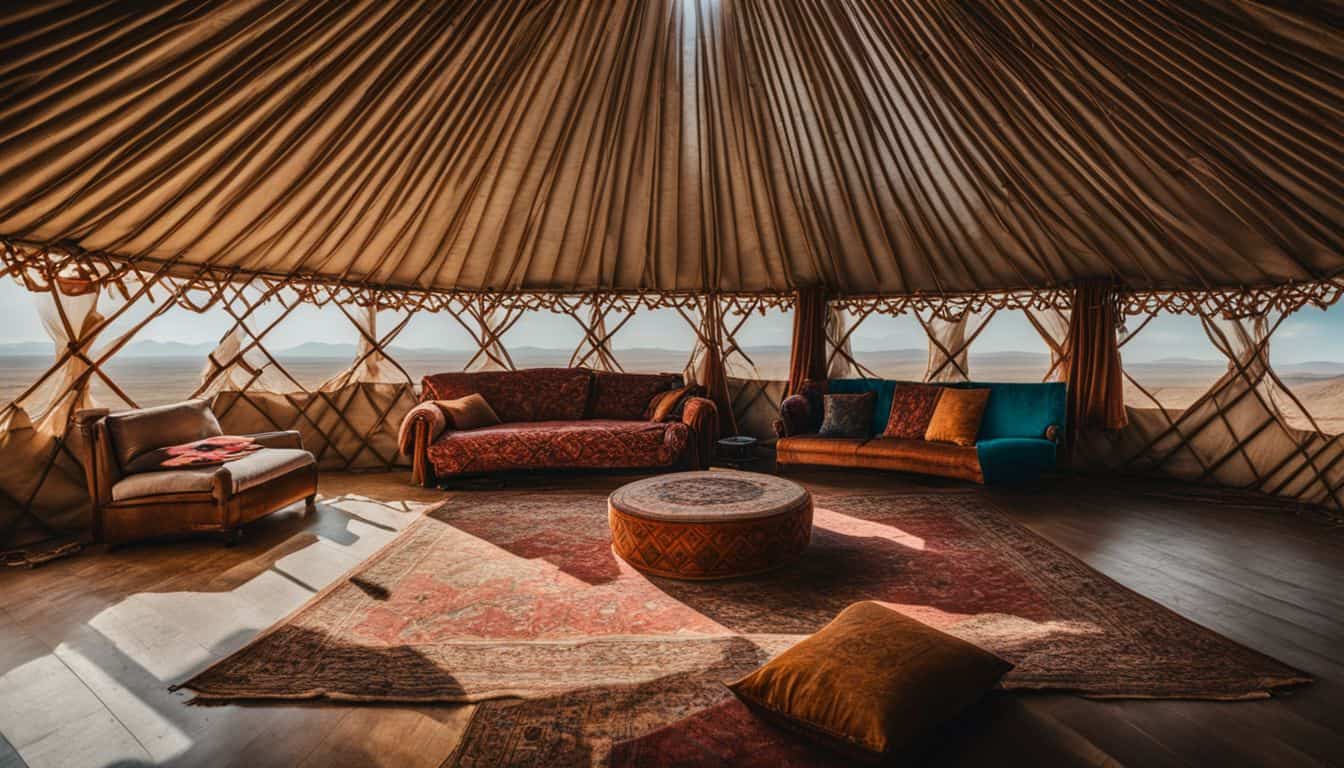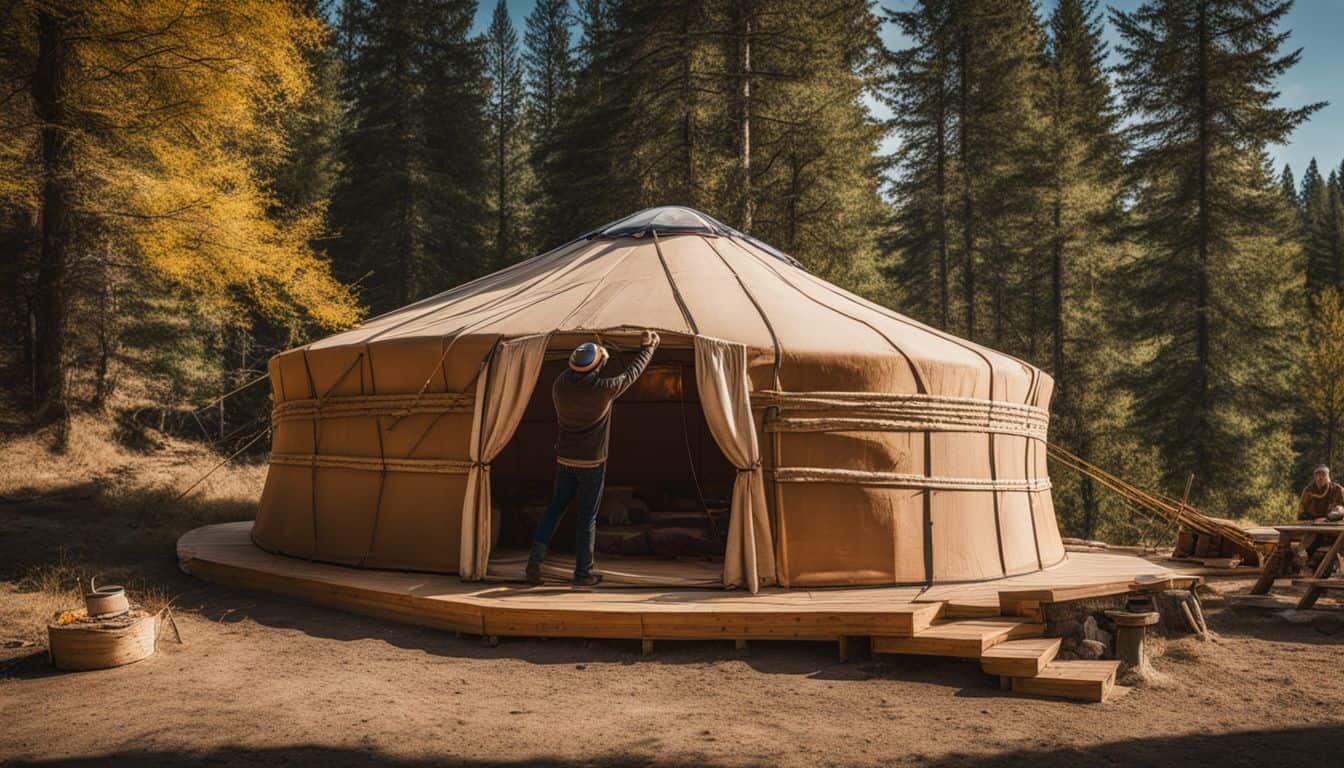Yurts, the circular, portable dwellings traditionally used by nomadic groups in Central Asia, have captivated imaginations for centuries. These ingenious structures have not only stood the test of time but have also found new relevance in our modern world. From their humble beginnings on the steppes to their current popularity in eco-tourism and wellness retreats, yurts continue to offer a unique blend of simplicity, functionality, and cultural richness.
Origins and Early History
The yurt’s origins can be traced back over 3,000 years to the nomadic tribes of Central Asia. These portable homes were perfectly adapted to the harsh, windswept landscapes and the nomadic lifestyle of their inhabitants. The earliest archaeological evidence of yurt-like structures dates back to the Bronze Age, with rock carvings and burial findings suggesting their use as far back as 600 BCE.
Structural Design and Symbolism
A traditional yurt consists of a wooden frame covered in felt or skins. The circular shape is not just practical for withstanding high winds; it also holds deep symbolic meaning. In many Central Asian cultures, the circle represents unity, family, and the cycle of life. The central opening at the top, known as the crown or tündük, serves as a smoke hole and a symbolic connection between earth and sky.
Yurts Across Cultures
While most commonly associated with Mongolia (where they’re called gers), yurts have been integral to many Central Asian cultures. While the Kyrgyz bozüy and the Turkish yurt are similar in basic structure, each has unique characteristics reflecting their specific cultural contexts. These variations showcase the adaptability of the yurt design across different environments and societies.
Cultural Significance
In nomadic societies, yurts were more than just shelters; they were the center of family and community life. Many rituals and ceremonies took place within or around the yurt, from births to weddings to funerals. Yurts also feature prominently in the folklore and mythology of Central Asian cultures, often symbolizing the cosmos or serving as settings for epic tales.
Traditional Craftsmanship
The art of yurt making is a cherished tradition passed down through generations. Artisans use natural materials like wood, wool, and animal hides, employing techniques honed over centuries. The decorative elements of a yurt, from the patterns on the felt coverings to the wooden carvings, often carry deep cultural meanings and showcase the artistic heritage of their makers.
Yurts in Modern Times
Today, yurts have found new life beyond their traditional contexts. They’ve become popular in eco-tourism, offering a unique glamping experience that combines comfort with a connection to nature. Some people have even adopted yurts as permanent, eco-friendly homes, appreciating their low environmental impact and energy efficiency.

Environmental and Sustainable Aspects
The yurt’s design inherently aligns with the principles of sustainable living. Its use of natural materials, efficient use of space, and minimal impact on the land make it an attractive option for those seeking to reduce their environmental footprint. Modern adaptations have enhanced these qualities, incorporating sustainable technologies while maintaining the yurt’s essential character.
Yurts in Popular Culture
Yurts have captured the imagination of artists, writers, and filmmakers, often symbolizing a simpler, more connected way of life. They’ve inspired modern architects to explore circular designs and have become a popular motif in various forms of art and design.
The Future of Yurts
As we look to the future, yurts continue to evolve. Innovations in materials and design are making them more durable and adaptable to various climates. There’s growing interest in incorporating yurts into urban settings, from public spaces to backyard offices. The yurt’s principles of simplicity and efficiency also align well with minimalist and tiny house movements.
Experiencing Yurt Life
For those intrigued by yurts, there are many ways to experience them firsthand. Many camping sites and retreats offer yurt accommodations, providing a taste of this unique living space. For a more immersive experience, cultural tours in countries like Mongolia or Kyrgyzstan offer stays in traditional yurts. Some companies even specialize in building custom yurts for personal use.

Conclusion
The enduring appeal of yurts lies in their remarkable ability to bridge ancient wisdom with modern needs. Yurts offer valuable lessons as we face sustainability challenges and seek meaningful connections with our environment and heritage. They remind us of the beauty in simplicity, the importance of adaptability, and the timeless human desire for shelter that nurtures both body and spirit.
Whether you’re interested in history, sustainable living, or simply seeking a unique experience, the world of yurts has something to offer. From their use in educational settings to their role in preserving traditional cultures, yurts continue to be relevant and inspiring. Consider exploring this fascinating dwelling type – you might find yourself captivated by the magic of yurt life!
FAQs
Who first lived in yurts?
The Scythians, ancient nomads from the Central Asian steppe, were some of the earliest people known to live in yurts.
What role did yurts play in Genghis Khan’s Mongol Empire?
Yurts served as portable homes for Genghis Khan and his Mongol tribes, allowing them to move quickly across vast lands during their conquests.
Can we see original Mongolian yurts today?
Yes, tourists visiting Mongolia’s capital, Ulaanbaatar, or exploring western Mongolia can find traditional yurts used by nomadic pastoralists just like centuries ago.
Are there modern versions of yurts around the world?
Indeed! Innovators like William Coperthwaite adapted the yurt design for clean and healthy living, sparking interest far beyond Mongolia.
Why are felt coverings important for a yurt?
Felt is central to insulation material for a classic Mongolian yurt; it withstands harsh weather while keeping the inside cozy and warm.
Is there more to Yurts than just housing in Mongolian culture?
Absolutely – they symbolize intangible cultural heritage linked with customs like Tengrism and are even celebrated through creative arts, from felting cashmere to crafting immersive science exhibits.

Leave a Reply